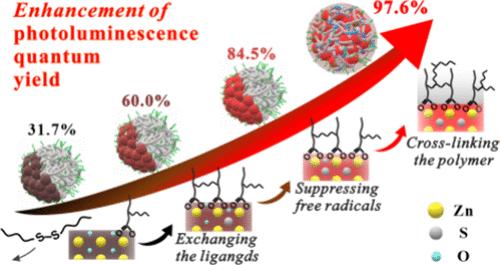当前位置:
X-MOL 学术
›
J. Am. Chem. Soc.
›
论文详情
Our official English website, www.x-mol.net, welcomes your feedback! (Note: you will need to create a separate account there.)
Multihierarchical Regulation To Achieve Quantum Dot Nanospheres with a Photoluminescence Quantum Yield Close to 100%
Journal of the American Chemical Society ( IF 14.4 ) Pub Date : 2024-06-21 , DOI: 10.1021/jacs.4c03308 Leping Lin 1 , An-An Liu 1 , Wei Zhao 1 , Yin Yang 1 , Dong-Liang Zhu 2 , Bo-Ran Dong 2 , Fei Ding 1 , Di Ning 1 , Xiaobo Zhu 3 , Dingbin Liu 1 , Dai-Wen Pang 1
Journal of the American Chemical Society ( IF 14.4 ) Pub Date : 2024-06-21 , DOI: 10.1021/jacs.4c03308 Leping Lin 1 , An-An Liu 1 , Wei Zhao 1 , Yin Yang 1 , Dong-Liang Zhu 2 , Bo-Ran Dong 2 , Fei Ding 1 , Di Ning 1 , Xiaobo Zhu 3 , Dingbin Liu 1 , Dai-Wen Pang 1
Affiliation

|
Quantum dots (QDs) exhibit superior brightness and photochemical stability, making them the preferred option for highly sensitive single-molecule detection compared with fluorescent dyes or proteins. Nevertheless, their high surface energy leads to nonspecific adsorption and poor colloidal stability. In the past decades, we have found that QD-based fluorescent nanoparticles (FNs) can not only address these limitations but also enhance detection sensitivity. However, the photoluminescence quantum yield (PLQY) of FNs is significantly lower compared with that of original QDs. It is urgent to develop a strategy to solve the issue, aiming to further enhance detection sensitivity. In this study, we found that the decrease of PLQY of FNs prepared by free radical polymerization was attributed to two factors: (1) generation of defects that can cause nonradiative transitions resulting from QD-ligands desorption and QD-shell oxidation induced by free radicals; (2) self-absorption resulting from aggregation caused by incompatibility of QDs with polymers. Based on these, we proposed a multihierarchical regulation strategy that includes: (1) regulating QD-ligands; (2) precisely controlling free radical concentration; and (3) constructing cross-linked structures of polymer to improve compatibility and to reduce the formation of surface defects. It is crucial to emphasize that the simultaneous coordination of multiple factors is essential. Consequently, a world-record PLQY of 97.6% for FNs was achieved, breaking through the current bottleneck at 65%. The flexible application of this regulatory concept paves the way for the large-scale production of high-brightness QD-polymer complexes, enhancing their potential applications in sensitive biomedical detection.
中文翻译:

多层次调控实现光致发光量子产率接近100%的量子点纳米球
与荧光染料或蛋白质相比,量子点 (QD) 表现出卓越的亮度和光化学稳定性,使其成为高灵敏度单分子检测的首选。然而,它们的高表面能导致非特异性吸附和胶体稳定性差。在过去的几十年里,我们发现基于量子点的荧光纳米颗粒(FN)不仅可以解决这些限制,还可以提高检测灵敏度。然而,FNs的光致发光量子产率(PLQY)明显低于原始QDs。迫切需要制定解决该问题的策略,旨在进一步提高检测灵敏度。在这项研究中,我们发现自由基聚合制备的FNs的PLQY下降归因于两个因素:(1)由于自由基诱导的QD配体解吸和QD壳氧化而产生缺陷,导致非辐射跃迁。 ; (2)量子点与聚合物的不相容性导致的聚集导致的自吸收。在此基础上,我们提出了多层次的监管策略,包括:(1)监管QD配体; (2)精确控制自由基浓度; (3)构建聚合物的交联结构以改善相容性并减少表面缺陷的形成。需要强调的是,多种因素的同时协调至关重要。最终,FN 的 PLQY 达到了 97.6% 的世界纪录,突破了目前 65% 的瓶颈。这一调控概念的灵活应用为高亮度量子点聚合物复合物的大规模生产铺平了道路,增强了其在敏感生物医学检测中的潜在应用。
更新日期:2024-06-21
中文翻译:

多层次调控实现光致发光量子产率接近100%的量子点纳米球
与荧光染料或蛋白质相比,量子点 (QD) 表现出卓越的亮度和光化学稳定性,使其成为高灵敏度单分子检测的首选。然而,它们的高表面能导致非特异性吸附和胶体稳定性差。在过去的几十年里,我们发现基于量子点的荧光纳米颗粒(FN)不仅可以解决这些限制,还可以提高检测灵敏度。然而,FNs的光致发光量子产率(PLQY)明显低于原始QDs。迫切需要制定解决该问题的策略,旨在进一步提高检测灵敏度。在这项研究中,我们发现自由基聚合制备的FNs的PLQY下降归因于两个因素:(1)由于自由基诱导的QD配体解吸和QD壳氧化而产生缺陷,导致非辐射跃迁。 ; (2)量子点与聚合物的不相容性导致的聚集导致的自吸收。在此基础上,我们提出了多层次的监管策略,包括:(1)监管QD配体; (2)精确控制自由基浓度; (3)构建聚合物的交联结构以改善相容性并减少表面缺陷的形成。需要强调的是,多种因素的同时协调至关重要。最终,FN 的 PLQY 达到了 97.6% 的世界纪录,突破了目前 65% 的瓶颈。这一调控概念的灵活应用为高亮度量子点聚合物复合物的大规模生产铺平了道路,增强了其在敏感生物医学检测中的潜在应用。
















































 京公网安备 11010802027423号
京公网安备 11010802027423号